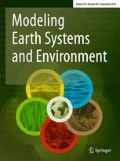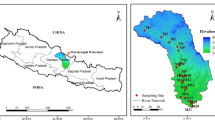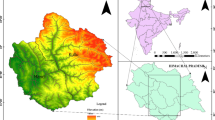Abstract
Nagavali River plays a major role in supporting agriculture and water supply demands in parts of the Kalahandi, Rayagada and Koraput districts of Odisha and Vizianagaram and Srikakulam districts of Andhra Pradesh. With the increase in demand for water and stress from the climate change, there is a need to understand the water balance of the river basin and suggest suitable measures to improve water resources development and water harvesting. In this study, a semi-distributed model, soil and water assessment tool (SWAT) is used to study the spatio-temporal water balance for the entire basin. The model was calibrated and validated at monthly scale using the observed river discharge at Srikakulam over a period of 15 years from 1985 to 2000. Calibration and Validation results for stream flow are satisfactory on a monthly scale. The seasonal water budget analysis reveals that 70% of the annual rainfall and 74% of the annual runoff occur during the monsoon season. The sensitivity analysis showed that the lateral flow travel time, average slope steepness, curve number, available water capacity of the soil basin are the most sensitive parameters. Further the spatial analysis of the water balance components show that there is considerable difference in the precipitation and streamflow within the basin ranging from 914 to 1319 and 82 to 246 mm respectively. The results from the study provide valuable information for the proposed interlinking projects in the future.








Similar content being viewed by others
References
Abbaspour KC, Yang J, Maximov I, Siber R, Bogner K, Mieleitner J, Zobrist J, Srinivasan R (2007) Modelling hydrology and water quality in the pre-alpine/alpine Thur watershed using SWAT. J Hydrol 333:413–430
Arabi M, Frankenberger JR, Engel BA, Arnold JG (2008) Representation of agricultural conservation practices with SWAT. J Hydrol Process 22:3042–3055
Arnold JG, Allen PM, Bernhardt G (1993) A comprehensive surface-groundwater flow model. J Hydrol 142(1–4):47–69
Arnold JG, Srinivasan R, Muttiah RS, Williams JR (1998) Large area hydrologic modeling and assessment part I: model development. J AWRA 34:1
Batelis S-C, Nalbantis I (2014) Potential effects of forest fires on streamflow in the Enipeas river basin, Thessaly, Greece. J Environ Process 1:73–85
Central Water Commission, Annual Report (2006–2007), Govt. of India
Chien H, Yeh PJF, Knouft JH (2013) Modeling the potential impacts of climate change on streamflow in agricultural watersheds of the Midwestern United States. J Hydrol 491:73–88, doi:10.1016/j.jhydrol.2013.03.026
Eckhardt K, Arnold J (2001) Automatic calibration of a distributed catchment model. J Hydrol 251:103–109
Garg KK, Wani SP, Barron J, Karlberg L, Rockstrom J (2012) Up-scaling potential impacts on water flows from agricultural water interventions: opportunities and trade-offs in the Osman Sagar catchment, Musi sub-basin, India. J Hydrol Process 27:3905–3921
Gassman P, Reyes M, Green C, Arnold J (2007) The soil and water assessment tool: historical development, applications, and future research directions invited review series transactions. J ASABE 50:1211–1250
Gosain A, Rao S, Srinivasan R, Reddy NG (2005) Return-flow assessment for irrigation command in the Palleru River basin using SWAT model. J Hydrol Process 19:673–682
Gupta HV, Sorooshian S, Yapo PO (1999) Status of automatic calibration for hydrologic models: Comparison with multilevel expert calibration. J Hydrol Eng 4:135–143
Hamed KH, Rao AR (1998) A modified Mann-Kendall trend test for autocorrelated data. J Hydrol 204(1–4):182–196
Himanshu SK, Pandey A, Shrestha P (2017) Application of SWAT in an Indian river basin for modeling runoff, sediment and water balance. J Environ Earth Sci 76:3
Holvoet K, Van Griensven A, Gevaert V, Seuntjens P, Vanrolleghem PA (2008) Modifications to the SWAT code for modelling direct pesticide losses. J Environ Model Softw 23:72–81
Jang SS, Ahn SR, Kim SJ (2016) Evaluation of executable best management practices in Haean highland agricultural catchment of South Korea using SWAT. J Agric Water Manag 180:224–234
Khare D, Patra D, Mondal A, Kundu S (2015) Impact of landuse/land cover change on run-off in a catchment of Narmada river in India. Appl Geomatics 7:23–35
Kim J, Choi J, Choi C, Park S (2012) Impacts of changes in climate and land use/land cover under IPCC RCP scenarios on streamflow in the Hoeya River Basin, Korea. J Sci Total Environ 452:181–195
Kumar S, Mishra A, Raghuwanshi NS (2014) Identification of critical erosion watersheds for control management in data scarce condition using the SWAT model. J Hydrol Eng 20:C4014008
Laflen J, Elliot W, Simanton J, Holzhey C, Kohl K (1991a) WEPP: Soil erodibility experiments for rangeland and cropland soils. J Soil Water Conserv 46:39–44
Laflen JM, Lane LJ, Foster GR (1991b) WEPP: A new generation of erosion prediction technology. J Soil Water Conserv 46:34–38
Legates DR, McCabe J (1999) Evaluating the use of goodness-of-fit measures in hydrologic and hydro climatic model validation. J Water Resour Res 35:233–241
Lenhart T, Eckhardt K, Fohrer N, Frede HG (2002) Comparison of two different approaches of sensitivity analysis. J Phys Chem Earth Parts A/B/C 27:645–654
Li D, Christakos G, Ding X, Wu J (2017) Adequacy of TRMM satellite rainfall data in driving the SWAT modelling of Tiaoxi catchment (Taihu lake basin, China). J Hydrol 0022–1694
Mani A, Mooley DA (1983) Wind energy data for India. Allied, New Delhi
Monteith JL (1965) Evaporation and the environment. In: 19th Symposia of the society for experimental biology: the state and movement of water in living organisms. Cambridge University Press, London, pp 205–234
Moriasi DN, Arnold JG, Van Liew MW, Bingner RL, Harmel RD, Veith TL (2006) Model evaluation guidelines for systematic quantification of accuracy in watershed simulations. J Trans Asabe 50:885–900
Murty P, Pandey A, Suryavanshi S (2013) Application of semi—distributed hydrological model for basin level water balance of the Ken basin of Central India. Hydrol Process 28:4119–4129
Narasimhan B, Srinivasan R, Bednarz ST, Ernst MR, Allen PM (2010) A comprehensive modeling approach for reservoir water quality assessment and management due to point and nonpoint source pollution. J ASABE 535:1605–1617
Narsimlu B, Gosain AK, Chahar BR (2013) Assessment of future climate change impacts on water resources of upper sind river basin, India using SWAT model. J Water Resourc Manag 27:3647–3662
Nash JE, Sutcliffe JV (1970) River flow forecasting through conceptual models part I- A discussion of principles. J Hydrol 10:282–290
Neitsch SL, Arnold JG, Kiniry JR, Williams JR, King KW (2002) Soil and water assessment tool theoretical documentation. Ver. 2000. USDA‐ARS Grassland Soil and Water Research Laboratory and Texas A&M University, Blackland Research and Extension Center, Temple, Texas
Park J (2011) Assessment of future climate change impacts on water quantity and quality for a mountainous dam watershed using SWAT. J T Asabe 54:1725–1737
Qi J, Li S, Li Q, Xing Z, Bourque CP-A, Meng F-R (2016) Assessing an enhanced version of SWAT on water quantity and quality simulation in regions with seasonal snow cover. J Water Resourc Manag 30:5021–5037
Rahman MM, Lin Z, Jia X, Steele DD, DeSutter TM (2012) Impact of subsurface drainage on streamflows in the Red River of the North basin. J Hydrol 511:474–483
Reshmidevi T, Kumar DN, Mehrotra R, Sharma A (2014) Estimation of the climate change impact on a catchment water balance using an ensemble of GCMs. J Hydrol 1694(17):30093–30096
Roth V, Nigussie TK, Lemann T (2016) Model parameter transfer for streamflow and sediment loss prediction with SWAT in a tropical watershed. J Environ Earth Sci 75:1321
Santhi C, Arnold JG, Williams JR, Dugas WA, Srinivasan R, Hauck LM (2001) Validation of the swat model on a large rwer basin with point and nonpoint sources. J AWRA 37:1169–1188
Schilling KE, Manoj KJ, Zhang YK, Gassman PW, Wolter CF (2008) Impact of land use and land cover change on the water balance of a large agricultural watershed: historical effects and future directions. J Water Resour Res 44:W00A09
Setti S, Maheswaran, Chandramouli Ch (2017) Hydrological modelling of Nagavalli River Basin. In: Proceeding of international conference on emerging trends in water resources and environmental engineering, India
Shrestha RR, Dibike YB, Prowse TD (2012) Modelling of climate-induced hydrologic changes in the Lake Winnipeg watershed. J Great Lakes Res 38:83–94
Shrestha S, Shrestha M, Shrestha PK (2017) Evaluation of the SWAT model performance for simulating river discharge in the Himalayan and tropical basins of Asia. J Hydrol Res 2017:189. https://doi.org/10.2166/nh.2017.189
Srinivasan R, Arnold JG (1994) Integration of a basin-scale water quality model with GIS. J AWRA 30:453–462
Srinivasan R, Ramanarayanan TS, Arnold JG, Bednarz ST (1998) Large area hydrologic modeling and assessment part II: model application. J AWRA 34:91–101
Suryavanshi S, Pandey A, Chaube UC (2016) Hydrological simulation of the Betwa River basin (India) using the SWAT model. J Hydrol Sci 62:960–978
Tarboton DG (2005) Terrain analysis using digital elevation models (TauDEM). Utah State University, Logan
Van Griensven A, Meixner T, Grunwald S, Bishop T, Diluzio M, Srinivasan R (2006) A global sensitivity analysis tool for the parameters of multi-variable catchment models. J Hydrol 324:10–23
Van Liew MW, Veith TL, Bosch DD, Arnold JG (2007) Suitability of SWAT for the conservation effects assessment project: comparison on USDA agricultural research service watersheds. J Hydrol Eng 12(2):173–189
White KL, Chaubey I (2005) Sensitivity analysis, calibration, and validations for a multisite and multivariable SWAT model. J AWRA 41(5):1077–1089
Willmott CJ (1981) On the validation of models. J Phys Geogr 2:184–194
Woznicki SA, Nejadhashemi AP, Abouali M, Herman MR, Esfahanian E, Hamaamin YA, Zhang Z (2012) Ecohydrological modeling for large-scale environmental impact assessment. J Sci Total Environ 543:274–286
Wua Y, Chen J (2014) Estimating irrigation water demand using an improved method and optimizing reservoir operation for water supply and hydropower generation: a case study of the Xinfengjiang reservoir in southern China. Agric Water Manag. https://doi.org/10.1016/j.agwat.2012.10.016
Acknowledgements
The financial assistance provided by Department of Science and Technology (DST), Government of India under the schemes of Inspire Faculty Award and the Early Career Research Award held by Dr.Maheswaran is gratefully acknowledged.
Author information
Authors and Affiliations
Corresponding author
Rights and permissions
About this article
Cite this article
Setti, S., Rathinasamy, M. & Chandramouli, S. Assessment of water balance for a forest dominated coastal river basin in India using a semi distributed hydrological model. Model. Earth Syst. Environ. 4, 127–140 (2018). https://doi.org/10.1007/s40808-017-0402-0
Received:
Accepted:
Published:
Issue Date:
DOI: https://doi.org/10.1007/s40808-017-0402-0




